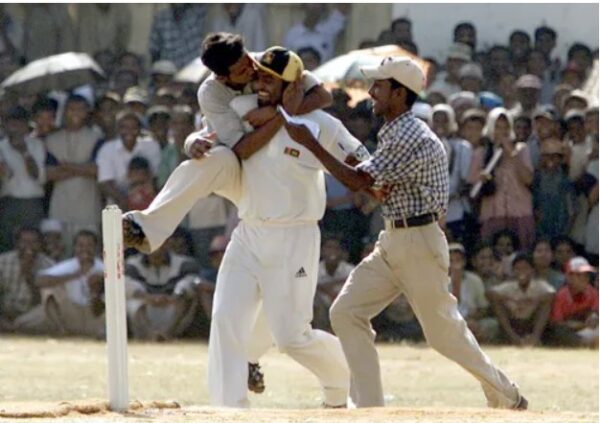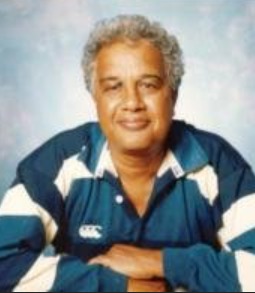Cricketing Amity, September 2002: Janashakthi XI vs Jaffna District Cricket XI-by Michael Roberts


During the ceasefire period after Eelam War III some leading members of the cricketing world in Colombo reached out in reconciliatory mood to Jaffna by organising a high-profile cricket match.[i]
Enthusiastic Jaffna Fans mob Murali
Chandra Schaffter: The Jaffna Match, 1 September 2002
With Ranil Wickremesinghe becoming Prime Minister in 2001, a ceasefire agreement was negotiated with the LTTE and the A9 was opened after many years. Janashakthi took the opportunity to open its Jaffna branch in August Because of our association with cricket, we felt that the best way would be to stage a cricket match which would bring the enthusiastic cricket fans in Jaffna out of their homes. It was a major rush but my son Ramesh,who was adept at such events, began organizing the match as well as the opening of the branch. I had just returned to Sri Lanka after managing the cricket team in the UK and I had agreed with a team of about 15 of the cricketers to go up to Jaffna in a special bus and play a match – not so much for cricket per se but in order to create an impression in Jaffna.
Unfortunately, the Interim Committee at that time behaved very churlishly and shot it down, and released only Murali, Kaluwitharana and Ruchira Perera (the latter as an invitee). All the rest were Janashakthi employees who had played first class cricket. We went up by bus and we had several camp followers who came on their own. It was a great occasion and a great picnic.
 Murali and others with the Branch staff
Murali and others with the Branch staff
 Murali as part of the procession heading towards the Branch opening …
Murali as part of the procession heading towards the Branch opening …

I will not dwell on the opening of the branch which was just like any other branches, but Jaffna was special because it had previously held a very highplace in the company’s operations. The match started as usual, and Janashakthi batted first. When it was Jaffna’s turn to bat, I believe I opened bowling and my figures,[ii] according to Ramesh, were 3 overs for 11 runs. I believe I took one wicket as well. Ruchira Perera opened at the other end and his figures were 3 overs for 27 runs.
We had a crowd of about 15,000 and controlling them was a major operation, particularly when Murali came anywhere near them. He also played and bowled and I think he took a couple of wickets. Jaffna in fact came quite close to our score thanks to Shah Jehan who made a fifty and plundered 16 runs or so from one Murali over.[iii]
The crowd mobbed the place, particularly Murali whose safety had to be looked after because the Board would not have forgiven us if he had been injured in anyway.
The LTTE were there in a big way however, they were allowed free movement without arms.[iv] Their cadres were around and their leader came and sat in the front row next to me. They were quite disciplined and happy about the event, because it added to the impression given that things were normal under them. The Police and Army too were very polite and co-operative and we had no problems at all. We stayed the night in Jaffna at various hotels and left the next morning for Colombo.
All in all, it was a great day and the participation of Murali helped to revive the flagging spirits of Jaffna sportsmen. I am sure that our competitors may have been quite envious at what we had achieved, but then that was the type of thing Janashakthi did from time to time.
Romesh Kaluwitharana’s Recollections
In the course of a Skype chat[v] Romesh indicated that Chandra Schaffter is “a good gentleman” and “a dear friend.” Romesh himself believed that “all of us are Sri Lankans whether Sinhala. Tamil or Muslim.” He was happy to participatein a good cause and to promote friendship. In brief, to interpolate, his outlook was ecumenical Sri Lanka in broad similarity with the stance advocated subsequently by Kumar Sangakkara.[vi]
Romesh was not critical of the SL Cricket Board for its reluctance to embrace the venture, but he was happy to join the cricketing party and his own family joined the entourage– [in a bus trip that involved a journey through Thamililam and the negotiation of border checkpoints]. They received a warm welcome from the Tamil people and were thrilled to take in the landscape and environment of the Jaffna Peninsula.
Kangadaran Mathivanan [one of the SL Cricket Board’s livewires] was hoping that the event would lead the way towards opening a cricket centre in the Peninsula. Three players in the Jaffna District Cricket team “did quite well” and were earmarked for potential moves to a higher level in the island’s competition.
However, said Romesh, these three did not survive the culling in subsequent competitions. Here, Romesh made it a point to stress that in recent times (last two decades?) about sixty (60) per cent of Sri Lanka’s cricketers have been from the outstations.
PS: A NOTE
In 2002 Schaffter, Kaluwitharana and Mahtivanan would not have been aware that Pirapāharan was determined to secure independence for Thamilīlam and quite confident of success – in short that the ceasefire would not last.[vii] That said, it would be a useful political finding to trace the subsequent cricketing and personal biography of all eleven players who represented Jaffna cricket on that occasion on 1 September 2002. Biographical sketches of this sort are clues to political subjectivity and a means of testing the waters of potential amity NOW…. In ways that may indicate how the varied cricketing hands of reconciliation from 2002 to 2017 have FAILED.
++++













